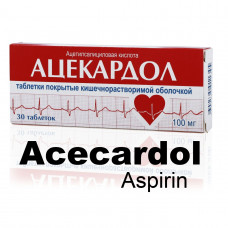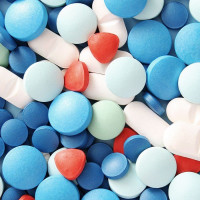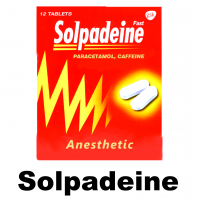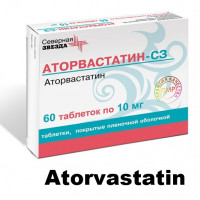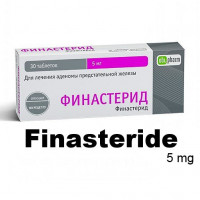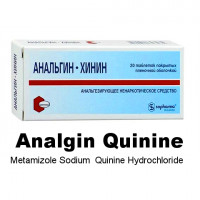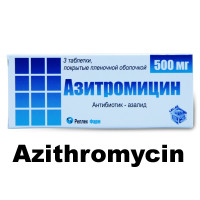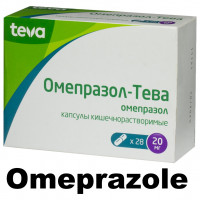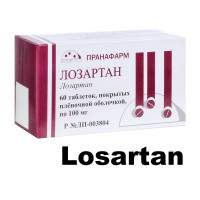Acecardol
Generic Name: Aspirin
Different dosages are possible. Ask for prices.
- Enteric tablets, cover film casing 30 pcs: 50 mg (acetylsalicylic acid)
- Enteric tablets, cover film casing 30 pcs: 100 mg (acetylsalicylic acid)
Enteric-coated tablets of white or almost white color, round, biconvex; cross-section - one layer of white or almost white.
Active substance: acetylsalicylic acid.
Clinical and pharmacological group: NSAIDs. Antiplatelet agent.
★Pharmachologic effect.
The mechanism of the antiplatelet action of acetylsalicylic acid (ASA) is based on irreversible inhibition of cyclooxygenase (COX-1), as a result of which the synthesis of thromboxane A2 is blocked and platelet aggregation is suppressed. The antiplatelet effect develops even after the use of small doses of the drug and lasts for 7 days after a single dose. ASA is believed to have other mechanisms of suppressing platelet aggregation.
In high doses, ASA (over 300 mg / day) also has anti-inflammatory, antipyretic and analgesic effects.
★Pharmacokinetics
Suction
After oral administration, ASA is rapidly and completely absorbed from the gastrointestinal tract. ASA is partially metabolized during absorption. During and after absorption, ASA is converted into the main metabolite - salicylic acid, which is metabolized mainly in the liver under the influence of enzymes with the formation of such metabolites as phenyl salicylate, salicylic acid glucuronide and salicylic acid, found in many tissues and in urine. In women, the metabolic process is slower (less enzyme activity in the blood serum).
Cmax of ASA in blood plasma is achieved within 10-20 minutes after ingestion, Cmax of salicylic acid - after 0.3-2 hours.
Due to the fact that the tablets are coated with an acid-resistant membrane, ASA is released not in the stomach (the membrane effectively blocks the dissolution of the drug in the stomach), but in the alkaline medium of the duodenum. Thus, the absorption of ASA in the form of enteric-coated tablets is slowed down by 3-6 hours compared to conventional (without such a coating) tablets.
Distribution
ASA and salicylic acid bind to blood plasma proteins (from 66% to 98% depending on the dose) and are rapidly distributed in the body. Salicylic acid passes through the placenta and into breast milk.
Withdrawal
The excretion of salicylic acid is dose-dependent, since its metabolism is limited by the capabilities of the enzymatic system. T1 / 2 ranges from 2-3 hours when using ASA in low doses and up to 15 hours when using the drug in high doses (usual doses of ASA as an analgesic and antipyretic agent). Unlike other salicylates, with repeated administration of the drug, non-hydrolyzed ASA does not accumulate in the blood serum. Salicylic acid and its metabolites are excreted by the kidneys. In patients with normal renal function, 80-100% of a single dose of the drug is excreted by the kidneys within 24-72 hours.
★Indications of the Acecardol:
- prevention of acute myocardial infarction in the presence of risk factors (for example, diabetes mellitus, hyperlipidemia, arterial hypertension, obesity, smoking, old age);
- prevention of recurrent myocardial infarction;
- unstable angina;
- prevention of ischemic stroke (including in patients with transient cerebrovascular accident);
- prevention of thromboembolism after surgery and invasive interventions on the vessels (for example, coronary artery bypass grafting, endarterectomy of the carotid arteries, arteriovenous bypass grafting, angioplasty and stenting of the coronary arteries, angioplasty of the carotid arteries);
- prevention of deep vein thrombosis and thromboembolism of the pulmonary artery and its branches (including with prolonged immobilization as a result of extensive surgical intervention).
★Dosage regimen
The tablets should be taken before meals with plenty of liquid, 1 time / day. Acecardol® is intended for long-term use. The duration of therapy is determined by the doctor.
Prophylaxis for suspected acute myocardial infarction: 100 mg / day daily or 300 mg every other day (the first tablet must be chewed for faster absorption).
Prevention of new-onset acute myocardial infarction in the presence of risk factors: 100 mg / day daily or 300 mg every other day.
Prevention of recurrent myocardial infarction and unstable angina pectoris: 100-300 mg / day daily.
Prevention of ischemic stroke and transient disorders of cerebral circulation: 100-300 mg / day daily.
Prevention of thromboembolism after operations and invasive interventions on the vessels: 100-300 mg / day daily.
Prevention of deep vein thrombosis and thromboembolism of the pulmonary artery and its branches: 100 mg / day or 300 mg every other day.
★Side effect
From the digestive system: nausea, heartburn, vomiting, abdominal pain; ulcers of the mucous membrane of the stomach and duodenum; perforated gastric and duodenal ulcers, gastrointestinal bleeding, transient liver dysfunction with increased activity of hepatic transaminases.
On the part of the hematopoietic system: the appointment of ASA is accompanied by an increased risk of bleeding due to the inhibitory effect of ASA on platelet aggregation, anemia.
Allergic reactions: skin rash, pruritus, urticaria, Quincke's edema, rhinitis, edema of the nasal mucosa, cardiorespiratory distress syndrome, as well as severe reactions, including anaphylactic shock.
From the respiratory system: bronchospasm.
From the side of the central nervous system: dizziness, hearing loss, headache, tinnitus.
★Contraindications for use
- erosive and ulcerative lesions of the gastrointestinal tract (in the acute phase);
- gastrointestinal bleeding;
- hemorrhagic diathesis;
- bronchial asthma induced by the intake of salicylates, complete or incomplete combination of bronchial asthma, recurrent polyposis of the nose and paranasal sinuses and ASA intolerance;
- severe renal failure (creatinine clearance (CC) less than 30 ml / min);
- severe hepatic insufficiency (class B and C on the Child-Pugh scale);
- chronic heart failure (NYHA functional class III-IV);
- simultaneous administration of methotrexate at a dose of 15 mg / week or more;
- I and III trimesters of pregnancy;
- lactation period;
- children under 18 years of age;
- lactase deficiency, lactose intolerance, glucose-galactose malabsorption;
- hypersensitivity to ASA.
With caution when:
- gout, hyperuricemia, because ASA in low doses reduces the excretion of uric acid; it should be borne in mind that ASA in low doses can provoke the development of gout in predisposed patients (with reduced uric acid excretion);
- gastric ulcer and duodenal ulcer or gastrointestinal bleeding (in history);
- impaired liver function (class A on the Child-Pugh scale);
- impaired renal function (CC more than 30 ml / min);
- bronchial asthma, chronic respiratory diseases, hay fever, nasal polyposis, drug allergies;
- simultaneous administration of methotrexate at a dose of less than 15 mg / week;
- concomitant anticoagulant therapy;
- II trimester of pregnancy;
- the proposed surgical intervention (including minor, for example, tooth extraction), because ASA can cause a tendency to develop bleeding for several days after taking the drug.
★Application during pregnancy and lactation
The use of salicylates in large doses in the first 3 months of pregnancy is associated with an increased incidence of fetal defects (cleft palate, heart defects). The appointment of salicylates in the first trimester of pregnancy is contraindicated.
In the second trimester of pregnancy, salicylates can be prescribed only taking into account a strict assessment of the risk to the fetus and benefits to the mother, preferably in doses not exceeding 150 mg / day and for a short time.
In the third trimester of pregnancy, salicylates in a high dose (more than 300 mg / day) cause a weakening of labor, premature closure of the ductus arteriosus in the fetus, increased bleeding in the mother and fetus, and administration immediately before childbirth can cause intracranial hemorrhage, especially in premature babies. The appointment of salicylates in the third trimester of pregnancy is contraindicated.
Salicylates and their metabolites pass into breast milk in small amounts, therefore, breastfeeding should be discontinued during lactation.
★Application for violations of liver function
Contraindicated in severe hepatic failure (class B and C on the Child-Pugh scale).
With caution in case of impaired liver function (class A on the Child-Pugh scale).
Application for impaired renal function
Contraindicated in severe renal failure (creatinine clearance (CC) less than 30 ml / min).
With caution in case of impaired renal function (CC more than 30 ml / min).
Application in children
Contraindication: under 18 years of age.
★Special instructions
ASA can provoke bronchospasm, as well as cause attacks of bronchial asthma and other hypersensitivity reactions. Risk factors include a history of bronchial asthma, hay fever, nasal polyposis, chronic respiratory diseases, and allergic reactions to other drugs (for example, skin reactions, itching, urticaria).
The inhibitory effect of ASA on platelet aggregation persists for several days after administration, which may increase the risk of bleeding during surgery or in the postoperative period. If it is necessary to absolutely exclude bleeding during surgery, it is necessary, if possible, to completely abandon the use of ASA in the preoperative period.
ASA in low doses can provoke the development of gout in susceptible individuals (with reduced excretion of uric acid).
With the combined use of GCS and salicylates, it should be remembered that during treatment, the concentration of salicylates in the blood is reduced, and after the abolition of GCS, an overdose of salicylates is possible.
Exceeding the dose of ASA is associated with the risk of gastrointestinal bleeding.
Influence on the ability to drive vehicles and use mechanisms
While taking the drug Acecardol ® , care should be taken when driving vehicles, mechanisms and when performing other potentially hazardous activities that require increased concentration of attention and speed of psychomotor reactions.
★Overdose
Overdose is unlikely due to the low content of ASA in the preparation. Exceeding the dose of ASA is associated with the risk of gastrointestinal bleeding. Overdose is especially dangerous in elderly patients.
Overdose symptoms from mild to moderate severity: dizziness, tinnitus, hearing impairment, increased sweating (including profuse), nausea, vomiting, headache, confusion, tachypnea, hyperventilation, respiratory alkalosis.
Treatment: gastric lavage, repeated intake of activated carbon, forced alkaline diuresis, restoration of water-electrolyte balance and acid-base state.
Moderate to severe overdose symptoms:
respiratory alkalosis with compensatory metabolic acidosis;
hyperpyrexia (extremely high body temperature);
respiratory disorders: hyperventilation, noncardiogenic pulmonary edema, respiratory depression, asphyxia;
disorders of the cardiovascular system: heart rhythm disturbances, lowering blood pressure, inhibition of cardiac activity;
violations of water and electrolyte balance: dehydration, impaired renal function from oliguria up to the development of renal failure, characterized by hypokalemia, hypernatremia, hyponatremia;
violation of glucose metabolism: hyperglycemia, hypoglycemia (especially in children), ketoacidosis;
tinnitus, deafness;
gastrointestinal bleeding;
hematological disorders: from inhibition of platelet aggregation to coagulopathy, prolongation of prothrombin time, hypoprothrombinemia;
neurological disorders: toxic encephalopathy and depression of the central nervous system (drowsiness, confusion, coma, convulsions).
Treatment: immediate hospitalization in specialized departments for emergency therapy - gastric lavage, repeated intake of activated charcoal, forced alkaline diuresis, hemodialysis, restoration of water-electrolyte balance and acid-base state, symptomatic therapy. When carrying out alkaline diuresis, it is necessary to achieve pH values between 7.5 and 8. Forced alkaline diuresis should be carried out when the concentration of salicylates in plasma is more than 500 mg / L (3.6 mmol / L) in adults and 300 mg / L (2.2 mmol / L) in children.
★Drug interactions
ASA, with simultaneous use, enhances the effect of the following drugs:
methotrexate by reducing renal clearance and displacing it from the connection with plasma proteins; also the combination of acetylsalicylic acid with methotrexate is accompanied by an increased incidence of side effects from the hematopoietic organs;
heparin and indirect anticoagulants due to dysfunction of platelets and displacement of indirect anticoagulants from the connection with plasma proteins;
thrombolytic agents and antiplatelet agents;
digoxin due to a decrease in its renal excretion;
hypoglycemic agents (insulin and sulfonylurea derivatives) due to the hypoglycemic properties of ASA itself in high doses and the displacement of sulfonylurea derivatives from the connection with plasma proteins;
valproic acid by displacing it from the connection with plasma proteins.
The combination of ASA with anticoagulants, thrombolytics and antiplatelet agents is accompanied by an increased risk of bleeding.
With the simultaneous administration of ASA with alcohol, an increase in the toxic effect of alcohol on the central nervous system is observed, the risk of damage to the mucous membrane of the gastrointestinal tract and lengthening of bleeding time increases.
ASA, when used simultaneously, weakens the effect of the following drugs:
uricosuric drugs - benzbromarone (decrease in the uricosuric effect due to competitive suppression of renal tubular excretion of uric acid);
ACE inhibitors (there is a dose-dependent decrease in the glomerular filtration rate as a result of inhibition of prostaglandins, which have a vasodilating effect, and, accordingly, a weakening of the hypotensive effect is observed);
diuretics (when combined with ASA in high doses, there is a decrease in the glomerular filtration rate as a result of a decrease in the synthesis of prostaglandins in the kidneys).
Enhancing the elimination of salicylates, systemic corticosteroids weaken their effect.
★Storage conditions Atsekardol preparation
The drug should be stored out of the reach of children at a temperature not exceeding 25 ° C.
★Shelf life of the drug Acecardol
The shelf life is 3 years.
★Terms of sale
The drug is approved for use as a means of OTC.
☆Different packaging design options are possible. Packing may be different, depends on the manufacturer. The composition of the tablets is the same. Medicine is made for the Russian market and has a the same design. Read the instructions on the Internet. Consult a doctor. Consider indications and contraindications for use.
☆Import duties, taxes, and charges are not included in the item price or shipping cost. These charges are the buyer's responsibility. Please check with your country's customs office to determine what these additional costs will be prior to bidding or buying.
☆Attention: Due to the ongoing worldwide pandemic, severe postal delays will occur. So we use registered post with Tracking Number. But please be kind enough to wait for about 2-3 months. We will make sure that you will get your package as soon as possible.
Acecardol
- Product Code: acecardol
- Availability: In Stock
-
$9.90 - $75.90
Available Options
Related Products
ANY MEDICATIONS
In addition to the medicines listed on this site, you can order any other medicines you need. Find o..
Solpadeine fast
{Pain Relief / Against Temperature and Headache} Solpadeine Fast Migraine, Headaches..
$11.90 - $48.90
Atorvastatin
Atorvastatin 10 mg Generic Equivalent To Lipitor Different dosages are possible. Ask ..
$11.90 - $40.90
Finasteride
Finasteride 5 mg Generic Equivalent To Proscar ★USES: Finasteride is used to shrink a..
$13.90 - $54.90
Analgin Quinine
Analgin Quinine {Pain Relief / Against Temperature and Headache} ★Sopharma’s Analgin Quini..
$18.90 - $174.90
Azithromycin 500 mg
Azithromycin 500 mg 1 Pack = 3 tablets Generic Equivalent To Zithromax Azithromycin i..
$13.90 - $74.90
Omeprazole
{Acid Reflux HeartBurn} Omeprazole Proton Pump Inhibitor ★Each capsule contains..
$8.90 - $78.90
Losartan
Losartan 50 mg Generic Equivalent To Cozaar Different dosages are possible. Ask for p..
$15.90 - $54.90

